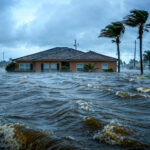True to its name, a 2012 flooding event is what initially sparked the idea for the commercial flood InsurTech, FloodFlash. Since then, the company has grown out of an apartment kitchen to a fully realized operation.
Co-founder Ian Bartholomew wrote about this in a blog on the company’s website, explaining that extensive flooding caused by Hurricane Sandy in New York gave him and his co-founder, Adam Rimmer, an idea.
Hurricane Sandy hit New York City in October 2012, resulting in the deaths of 44 city residents and inflicting an estimated $19 billion in damages, according to the City of New York’s website. In July 2013, it was announced that First Mutual Transportation Assurance Company, a New York state licensed and domiciled captive insurance company and subsidiary of the Metropolitan Transportation Authority, would for the first time utilize the cat bond market to manage its storm surge risks in the New York City metropolitan region.
This came as traditional avenues for insurance and reinsurance contracted dramatically in the aftermath of Superstorm Sandy, making it difficult for the MTA to obtain coverage, according to a press release issued by GC Securities, a division of MMC Securities Corp. – the U.S. registered broker/dealer that placed the bond. The newly formed catastrophe bond shelf program, MetroCat Re Ltd., served as the first cat bond ever to protect solely against storm surge risk, according to the release.
While catastrophe bonds have historically been available to large corporations, governments and even insurance companies themselves, Bartholomew wrote in FloodFlash’s blog, he found that smaller businesses at risk of flooding can have trouble buying traditional flood insurance or could be subject to higher premiums, larger deductibles, and reduced limits.
With this in mind, Bartholomew and Rimmer decided to use technology to bring parametric insurance to this segment of the market. Starting first in the U.K. from the kitchen of Bartholomew’s apartment in September 2016, FloodFlash later launched in the U.S. in 2019.
***
Learn more about FloodFlash: Adam Rimmer speaks with Elizabeth Blosfield on the podcast, “How Climate Risk is Fueling Innovation in Insurance – Insurance Journal TV“
***
Parametric insurance covers a policyholder against a specific event by paying a set amount based on the magnitude of the event rather than the magnitude of the loss.

“This type of insurance has been common for governments and the largest corporations for a while now,” FloodFlash CEO Mark Hara told Carrier Management. “FloodFlash uses data science and technology to make it available to a much wider audience. That’s our mission. We are here to use parametric insurance to help more businesses recover from catastrophic flooding.”
Hara said three pieces of tech are behind this mission. FloodFlash’s pricing team has rated every building in the U.S. and is able to review a quote without information on flood zone or first flood height. The team then delivers those prices through its cloud-based underwriting platform. The final piece, Hara said, is FloodFlash’s smart sensor, which uses internet of things technology to measure flood water at the insured property.
“When flood water reaches the client’s trigger depth, we begin the claim,” he said. “Claims are administered fully remotely, and we update clients throughout.”
Hara said the InsurTech, which operates as a managing general agency, isn’t seeking to replace any of the flood coverage options currently available in the market. Instead, it aims to provide an alternative when coverage gaps exist.
With flood maps that are decades old and out of step with current climate conditions, according to Aon Edge CEO John Dickson in an October webinar for Carrier Management, flood coverage gaps are a growing, and expensive, problem for consumers.
“(If) you’re using history, that’s from a flood perspective, out of date,” he said. “And so, unfortunately, water doesn’t know to stop at these lines that we draw upon maps.”
Hara said his team is seeking to solve for these major coverage problems, as well as smaller issues that he sees with business interruption coverage and rebuilding regulations.
“Perhaps [consumers] don’t have business interruption coverage, or they need extra money to comply with rebuilding regulations,” he said. “These smaller gaps are equally important and also ones that we are looking to solve.”
He said he believes the market is ready for this type of platform as severe weather events are becoming more frequent and unpredictable.
“The main [challenge] is that [climate change] makes it harder to use historical data to predict what might happen in the future,” he said. “That said, while we are seeing a trend of more frequent extreme weather around the globe, a lot of the issues within the flood market have been there for a long time. We often say that FloodFlash is here to help businesses that need support now, not just those that will need it in 2050.”
After spending 12 years in marketing and distribution roles before joining Nationwide Insurance as chief innovation officer, Hara transitioned to InsurTech in chief operating officer roles. He worked on creating and scaling the consumer insurance platform at Mylo before leading the sales, marketing, and customer operations at Bold Penguin. After a conversation with Bartholomew and Rimmer about their mission, he landed at FloodFlash. He said he not only believes in the company’s mission, but now, he sees a future even beyond flood.
“We can take this technological approach to parametric insurance and apply it to almost any peril. That could be other environmental risks, or something broader like non-damage BI,” he said. “Flood is only the beginning.”




















 Four P/C Insurers Are ‘AI Titans’; AI Impact Leaders Revealed: Research
Four P/C Insurers Are ‘AI Titans’; AI Impact Leaders Revealed: Research  Auto Insurer Files $450M Fraud RICO Case in NY
Auto Insurer Files $450M Fraud RICO Case in NY  What’s Not Changing in 2025: Homeowners Outlook, Re Retentions
What’s Not Changing in 2025: Homeowners Outlook, Re Retentions  Moody’s: Rising Flood Risks Posing Greater Challenges for Eastern and Southern U.S.
Moody’s: Rising Flood Risks Posing Greater Challenges for Eastern and Southern U.S. 





